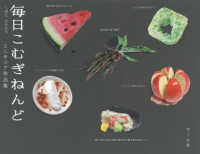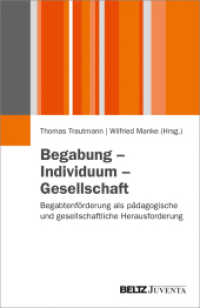- ホーム
- > 洋書
- > ドイツ書
- > Social Sciences, Jurisprudence & Economy
- > Politics, Society, Work
- > public administration
Full Description
The book interprets and recombines, within a subjective trajectory, some roots, pathways and conceptual frames of the planning thought that worked either as dissenting imaginations or generative source to critically question the modernist epistemologies. 'Critical planning and design' is presented in this book as a field of research inspired by critical urban theory and developed along with ideas and theories that prove to be radical, alternative, dialectical to the mainstream history of planning.
In this book, scholars present what they consider as the most important books in the field of planning, public policy and design. They have been asked to write about a book and its author, in their preferred manner. This freedom allowed passionate and original contributions.
Three main threads - the three parts of the book - shape the choices of the authors. The first concerns the reconstruction of some genealogical roots of planning (including Cerdà, YonaFriedman, Alberto Magnaghi, and Ian McHarg). The second thread groups the authors who dialogue with contemporary protagonists of the planning debate (including John Friedmann, Leonie Sandercock, Doreen Massey, David Harvey, Tom Sievert, and Patzy Healey). The third thread includes authors who dig into relevant writings in social and philosophical sciences (including Max Weber, Charles Lindblom, Henri Lefebvre, Gilles Deleuze & Félix Guattari, Georges Didi-Huberman, Robert Nozick, Pand hilip K Dick).
The book is addressed to researchers of planning and urban studies, who value the critical re-reading of some fundamental books. Including thoughtful and critical arguments on influential thinkers of the past two centuries, the book will enable students, scholars and researchers of planning, design, political science, geographical, environmental, and urban studies to better understand the socio-spatial and ecological transformations under the contemporary transitionwhile relying on a "usable past". The book is also addressed to a wider audience of readers interested in the problems of the city and space.
Contents
Introduction: Critical planning and design: Walking through roots and dissenting imaginations.- Part 1: Roots.- Giancarlo Paba's trilogy of Luoghi comuni (Common Places, 1998), Movimenti urbani (Urban Movements, 2003), Corpi urbani (Urban Bodies, 2010): Influential Italian 'critical planning' thinking.- Ildefonso Cerdà, Teoría General de la Urbanización, 1867: An innovative approach.- L'Ordine politico della Comunità (The Political Order of Community) 2014: Concrete community and territorial principle in Adriano Olivetti's thought.- All the layers of an ecological commitment at the frontier: Ian McHarg, Design with Nature, 1969.- L' Architecture de survie (1978) is back talking to EU cities in crisis: The provocative message by Yona Friedman as a key for the present and future urban agenda.- Part 2: Planning pathways.- John Friedmann, The Good Society (1979): Panning pathways for a just society.- David Harvey's Urbanization of Capital (1985): Why it helped me so much.- A place in the world? Places, Cultures and Globalization, 1995. Doreen Massey's lessons: Is the world really shrinking or is the geography of the world teaching us openness and diversity?.- Patsy Healey and Collaborative Planning (2005): Re-thinking democracy in the 'reasoning in public' arena.- Utopian tension: Sandercock's inspiring journey "Towards Cosmopolis" (1998).- Zwischenstadt | Inbetween city. Thomas Sieverts, Cities Without Cities: An interpretation of the Zwischenstadt, 2004.- Part 3: Conceptual frames.- Inquiry and change: The troubled attempt to understand and shape society, 1990: The radical contribution of Charles E. Lindblom's self-guiding society and probing volitions.- Rediscussing Robert Nozick's Anarchy, State and Utopia, 1974.- Property titles to land and issues of distributive justice.- Blade Runner, 1982. Do Androids dream of electric sheep?- Philip K Dick's science fiction and Maschinenmenschen in Metropolis.- Max Weber, Die Stadt (1922), English edition, Max Weber, The City,edited and traslated by Don Martindale and Gertrude Neuwirth, The Free Press, 1958.- Antonio Gramsci and the prison notebooks.- Le droit à la ville, 1968: Reading Lefebvre's the right to the city in planning perspective.- The trouble with Henri: The production of urban space - from theory to research.- Gilles Deleuze & Félix Guattari, Mille Plateaux, 1980: "The good use of philosophy".- Georges Didi-Huberman, La survivance des lucioles (2009). The thickness of time: going beyond the surface of the present to understand contemporary territories.







